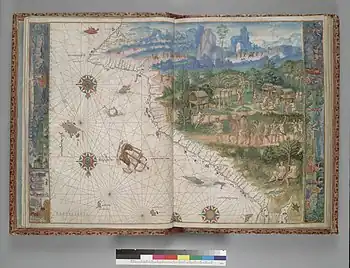
The Vallard Atlas is a world atlas, one of the Dieppe school of maps, produced in 1547. It is believed to have been owned by Nicolas Vallard, its authorship being unknown.[1]
History
It is considered one of the most notable 16th-century atlases of the Dieppe school of Cartography. It is believed that Nicholas Vallard was the first owner and this is why the publication bears his name [2]
The atlas is held at the Huntington Library based in San Marino, California, USA.
Description
The atlas consists of 68 pages, and contains 15 nautical charts with rich illustrations as well as a calendar and some in-depth maritime information. The atlas contains numerous illuminations that show the New World’s inhabitants, and this is why it is considered a valuable testimony of discovery. The original publication is bound in crimson leather with golden decorations.
The maps depicted in the atlas are inverted compared to modern depictions, as the North Pole is placed on the bottom side of the atlas while the South Pole is placed on the top.[3]
There is some speculation that like some other works of the Dieppe school of maps, the atlas may show the Australian coastline with its depiction of a continent labelled Jave la Grande, which would mean it was created before the documented discoveries of Willem Janszoon or James Cook.[3][4][5] However, most historians do not accept this theory, and the interpretation of this feature of the Vallard and other Dieppe maps is highly contentious.[6][7][8][9][10]
References
- ↑ "Guide To Medieval and Renaissance Manuscripts in the Huntington Library : PORTOLAN ATLAS, anonymous". Bancroft.berkeley.edu. Archived from the original on 28 September 2012. Retrieved 4 September 2015.
- ↑ Lapouge, Gilles (2012). "L'énigme de l'atlas dieppois". Geohistoire (2): 104–111.
- 1 2 Thomaz, Luís Filipe F.R.; Reinhartz, D.; García-Tejedor, C.M. (2010). Atlas Vallard, Libro de estudio. M. Moleiro.
- ↑ K.G. McIntyre (1977), The Secret Discovery of Australia; Portuguese discoveries 200 years before Captain Cook. (Souvenir Press, Medindie, South Australia. ISBN 0-285-62303-6)
- ↑ Trickett, P. (2007), Beyond Capricorn: How Portuguese adventurers discovered and mapped Australia and New Zealand 250 years before Captain Cook. (East St. Publications. Adelaide. ISBN 978-0-9751145-9-9)
- ↑ Richardson, William Arthur Ridley (1989). The Portuguese Discovery of Australia, Fact or Fiction?. Canberra: National Library of Australia. p. 6. ISBN 0642104816. Retrieved 2 March 2016.
- ↑ "A voyage of rediscovery about a voyage of rediscovery". The Guardian. London. 26 March 2007. Retrieved 25 February 2016.
- ↑ Robert J. King, "The Jagiellonian Globe, a Key to the Puzzle of Jave la Grande", The Globe: Journal of the Australian Map Circle, No. 62, 2009, pp. 1–50.
- ↑ Robert J. King, "Regio Patalis: Australia on the map in 1531?", The Portolan, Issue 82, Winter 2011, pp. 8–17.
- ↑ Gayle K. Brunelle, "Dieppe School", in David Buisseret (ed.), The Oxford Companion to World Exploration, New York, Oxford University Press, 2007, pp.237–238.